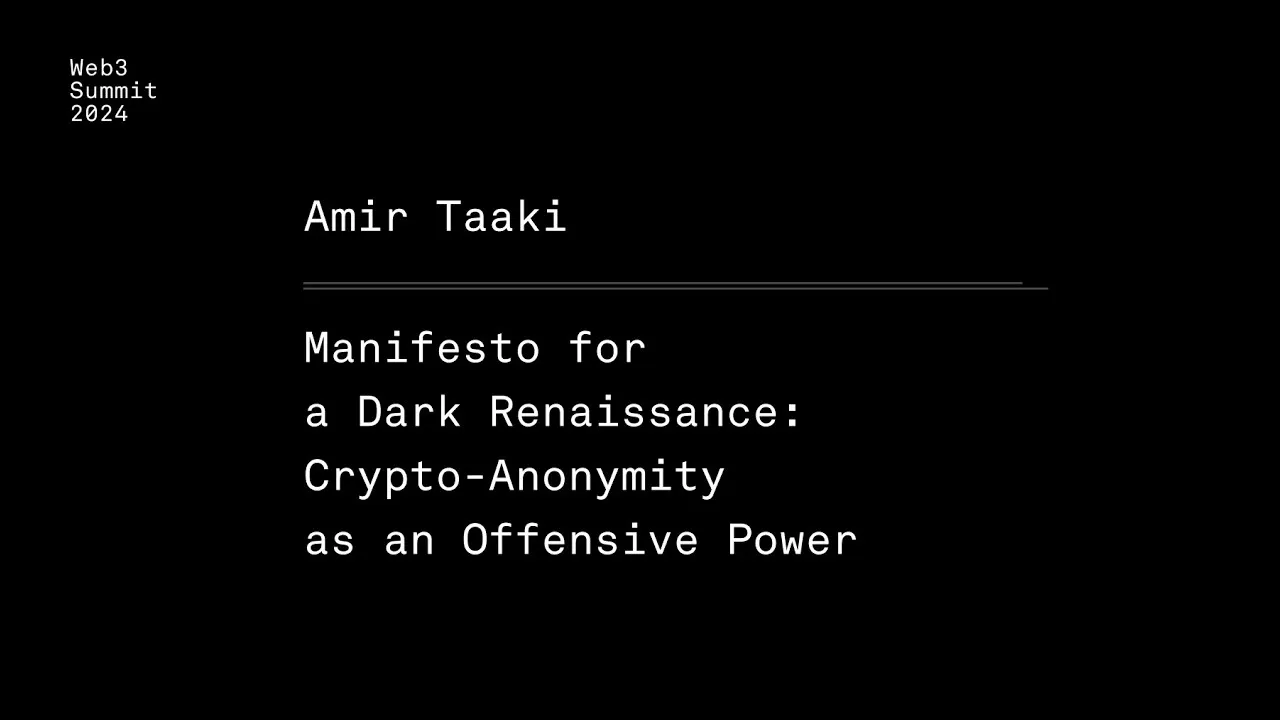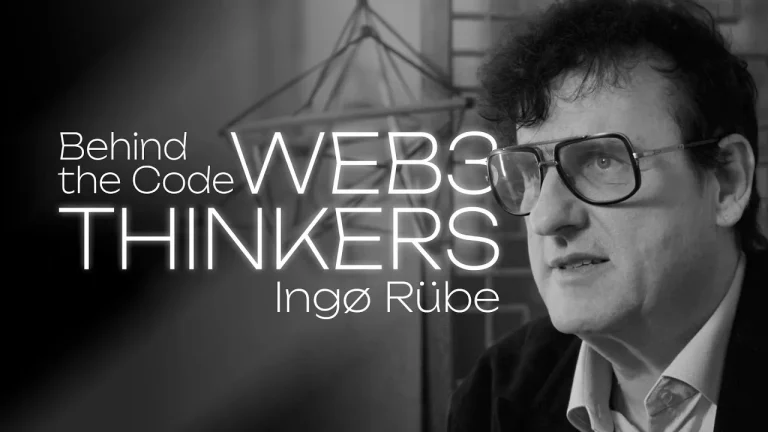At the Web3 Summit 2024, Amir Taaki, a prominent figure in the blockchain and cryptocurrency landscape, presented a compelling talk titled “Manifesto for a Dark Renaissance.” Taaki is known for his controversial yet visionary ideas, contributing significantly to the evolution of the crypto world since its early days. His keynote delved into the direction of cryptocurrency, the clash between centralized institutions and decentralized technologies, and the emerging dichotomy between “RegiFi” and “DarkFi.” This article explores Taaki’s thoughts and their implications for the future of blockchain and the wider Web3 movement.
Amir Taaki: A Crypto Pioneer with a Radical Vision
Amir Taaki is a renowned British-Iranian software developer and early Bitcoin enthusiast. Having been involved in Bitcoin development since 2010, Taaki’s contributions to the cryptocurrency space have left a lasting mark. He is credited with the creation of CoinJoin, a privacy-enhancing Bitcoin protocol, and his early work on the first web-based Bitcoin wallets. He is also one of the early proponents of decentralized finance (DeFi) and a strong advocate for privacy, anonymity, and anti-establishment ideals within the blockchain community.
Taaki’s talk at the Web3 Summit, titled “Manifesto for a Dark Renaissance”, echoed his longstanding belief that cryptocurrency and blockchain technology represent a force for freedom against oppressive systems. He dedicated his speech to Jay Stark, Ross Ulbricht, and John McAfee, three figures who he believes played a crucial role in shaping the crypto movement by challenging the status quo.
The Post-Maximalism Era: A Shift in Crypto’s Ideals
During his talk, Taaki referred back to his 2019 Web3 Summit presentation titled “Post-Maximalism”. He explained that this previous talk centered on the future trajectory of cryptocurrency and how the movement had drifted away from its initial ideals of decentralization and resistance to centralized powers. He referenced the work of his colleague Ashley Tyson, co-founder of the Web3 Foundation, who had invited him to speak about the future of blockchain and cryptocurrency.
Taaki highlighted a growing division in the crypto space, which he referred to as the “RegiFi-DarkFi split“. This concept encapsulates the tension between regulated, compliant financial systems (RegiFi) and decentralized, privacy-focused projects (DarkFi). He argued that the rise of RegiFi signals a shift towards institutional collaboration and compliance, which he views as a betrayal of cryptocurrency’s original mission.
DarkFi: The Emergence of a New Paradigm
At the heart of Taaki’s vision for the future is DarkFi, a decentralized ecosystem that emphasizes privacy, anonymity, and resistance to state control. DarkFi stands in contrast to RegiFi, which represents the regulated, compliant side of the cryptocurrency world, heavily influenced by governments and institutions. According to Taaki, RegiFi projects are fragile and dependent on the goodwill of governments and regulators, making them vulnerable to external control.
DarkFi, on the other hand, is built on the principles of privacy and decentralization. Taaki and his team have developed a series of tools and applications designed to create a self-sustaining, antifragile ecosystem that can resist state oppression. Among the innovations he discussed were fully anonymous decentralized autonomous organizations (DAOs), peer-to-peer communication tools, and privacy-preserving smart contracts.
Anonymous Tools for the DarkFi Ecosystem
Taaki’s DarkFi ecosystem comprises a suite of decentralized tools aimed at promoting freedom and privacy in an increasingly surveilled world. These tools are designed to enable secure communication, anonymous trading, and decentralized governance without relying on centralized infrastructure or institutions.
1. Anonymous Chat Applications
One of the key components of DarkFi is the world’s most anonymous peer-to-peer chat application. Taaki emphasized that the chat platform allows users to change their nicknames at any time, ensuring there is no linkability between messages and identities. This system is designed to prevent the kind of liability that centralized messaging platforms create, where conversations can be traced back to individuals. The application runs on the Tor network, further enhancing anonymity.
2. Anonymous DAOs
Taaki also discussed the development of fully anonymous DAOs, where no one can identify the participants, see the proposals, or trace the voting processes. These DAOs enable decentralized governance while preserving the anonymity of those involved. Taaki highlighted the importance of anonymity in protecting political dissidents, activists, and individuals who may be targeted by authoritarian regimes for their involvement in decentralized organizations.
3. Anonymous Swaps and Markets
The DarkFi ecosystem also includes anonymous swap mechanisms, allowing users to trade assets without revealing their identities. This is a critical component of Taaki’s vision for a decentralized economy, where individuals can engage in trade and financial transactions without state interference. Taaki believes that these anonymous tools are essential for resisting government oppression and creating a free, decentralized economy.
The Role of Cryptocurrency in Resisting Oppression
Throughout his talk, Taaki emphasized that cryptocurrency and decentralized technology have the potential to undermine the authority of nation-states. He described cryptocurrency as “cyber money” that cannot be controlled by governments, and he argued that private, market-issued digital money is far superior to government-issued fiat currency. Taaki views cryptocurrency as the ultimate hedge against government overreach and authoritarianism.
Taaki also addressed the issue of government surveillance, pointing to the use of closed-circuit television (CCTV) cameras and other surveillance technologies in cities like London. He argued that the mass adoption of privacy-enhancing technologies, such as those developed within the DarkFi ecosystem, is crucial for protecting individuals’ rights in an increasingly surveilled world.
A Call for a Moral Revolution in Cryptocurrency
Reflecting on the events surrounding the collapse of FTX and the broader crypto market downturn, Taaki called for a “moral revolution” in the cryptocurrency space. He argued that many individuals and organizations within the crypto community have lost sight of the movement’s original goals, focusing instead on profit and financial gain. Taaki criticized the “coinery” and NFT trading culture, which he believes detracts from the true purpose of blockchain technology: to create a decentralized, free, and just society.
Taaki expressed frustration with the current state of the crypto industry, where he believes many projects have become self-serving and compliant with government regulations. He urged the community to return to the movement’s roots, advocating for privacy, decentralization, and the dismantling of oppressive systems.
The Future: A Dark Renaissance
In conclusion, Amir Taaki’s “Manifesto for a Dark Renaissance” at the Web3 Summit 2024 outlines a vision for the future of cryptocurrency that is grounded in privacy, decentralization, and resistance to state control. His DarkFi ecosystem represents a radical departure from the regulated, compliant systems that dominate much of the crypto landscape today.
Taaki believes that as governments and institutions crack down on decentralized technologies, they will only strengthen the case for DarkFi and similar projects. In his view, the increasing authoritarianism and surveillance in society will drive people towards anonymous, decentralized systems that protect their freedoms.
Taaki’s vision for a “dark renaissance” is not without its challenges, but it reflects the spirit of rebellion and innovation that has always been at the heart of the crypto movement. As the Web3 space continues to evolve, it remains to be seen whether the ideals of DarkFi will take hold and shape the future of decentralized technology.








